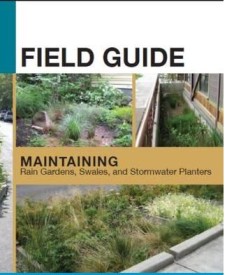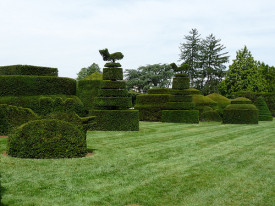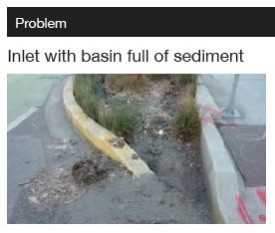
Rain garden maintenance has emerged as one of the big hurdles to expanding the use of green stormwater solutions. You build it. The rain comes. Then what?
In some ways, the water-absorbing gardens are not much different than other landscaping features. They need weeding, some summer irrigation, and basic pruning. But they also require more nuanced care.
The standard “mow, blow, and go” strategy that sends some commercial landscapers whacking plants and lawns with mowers or hedge trimmers, then revving up the leaf blower to blast the ground clean just won’t cut it. Rain gardens need lusher plantings to catch rain in their leaves and branches and healthy roots to help water soak into the ground. The green infrastructure often features a thicker cover of water-trapping mulch. Good rain garden maintenance means saying ‘no’ to Edward Scissorhands-inspired pruning and bare soil. It requires attention to how the water flows into—and sometimes out of—the garden, and how quickly the water seeps into the ground.
To help solve these maintenance challenges, some smart stormwater folks in Oregon have released “Field Guide: Maintaining Rain Gardens, Swales and Stormwater Planters (2013),” a handy how-to for keeping rain gardens functional as well as beautiful. The guide opens with specific recommendations on what tools you’ll need for rain garden maintenance, gives cautionary notes—and scary photos!—of some of the injury-inducing weeds lurking out there, and provides explicit instructions on how to maintain the gardens’ stormwater treating capacity.

The illustrated manual that I featured last week, “Rain Garden Handbook for Western Washington: A Guide for Design, Installation, and Maintenance” from Washington State University, is a perfect companion to this new guide from Oregon. The Washington handbook addresses maintenance, but the Oregon guide provides a more detailed, in-depth examination of how to recognize and fix a multitude of rain garden troubles.
The Field Guide includes a calendar showing which season is best for different maintenance activities such as weeding, re-planting, and pruning. It has a check list for maintenance crews to use in the field to make sure they don’t miss any important steps. And there are clear photos and descriptions of a variety of rain garden woes. Is erosion creating a system of mini rivers draining into the rain gardens? Try erosion-control matting and refilling the channels with top soil. Is sediment creating sandy dams blocking the flow of water into the garden? Get your rake or shovel and get digging.
The document was a team effort by Clackamas County Water Environment Services, Clean Water Services, East Multnomah Soil and Water Conservation District, Green Girl LDS, Metro, City of Portland Environmental Services, Pacific Landscape Management, and Pacific Sports Turf.

Oregon stormwater experts are recognized leaders in the maintenance arena. The city of Portland program is so well conceived that one Puget Sound county has made multiple trips to check out their program, even taking photos of the Portland maintenance trucks in order to replicate them back home.
If you’re looking for still more maintenance inspiration, Montgomery County in Marylandhas a comprehensive website with strategies for healthy rain gardens. Additionally, the University of New Hampshire Stormwater Center has some helpful maintenance tips and check lists.
So no excuses, folks. Put down your power hedge clippers and diagram for topiary ducks, grab your Rain Garden Handbook and Field Guide, and get your gardens growing.


Comments are closed.